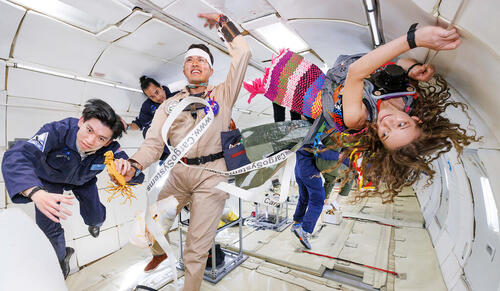
Picture a spacesuit. It’s functional, and the mirrored visor is fun. But you can’t dance in it.
While the first astronaut to set foot on Mars probably won’t pirouette or perform a jazz split on the planet’s rust-colored soil, folks at Yale are nonetheless thinking about how to encourage artistic expression in space exploration.
In the spring course “The Mechanical Artifact: Ultra Space,” Yale students from several disciplines were asked to design and build a flight suit that would help tomorrow’s astronauts express themselves creatively in zero gravity. What they’ve imagined would also provide travelers reminders of home and humanity as they hurtle into the unknown.
Constructed of a mix of found materials and ingeniously engineered components, the suit they created is inspired by their examination of questions connecting architecture, design, and artistry to humankind’s future in space. While not a traditional life-support system, the suit’s mechanisms would allow its wearer to bring lively, colorful performance to an orbiting space station or Martian settlement.
“And the suit performed amazingly well.”
The course and the zero-g experience were part of a collaboration between the Yale School of Architecture; Yale’s Center for Collaborative Arts and Media (CCAM), an interdisciplinary arts hub that activates creative research and practice across disciplines; and the MIT Media Lab Space Exploration Initiative, which supports research aimed at democratizing access to space and chartered the parabolic flight.
CCAM Director Dana Karwas, a critic at the School of Architecture, established and taught the class with Yale alumna Ariel Ekblaw ’14 B.S., founding director of MIT’s Space Exploration Initiative, who secured spots for Yale on the zero-g flight. It was the second iteration of the course, which was first offered last year.
During the spring 2021 semester, students designed innovative devices and objects intended to enhance the experience of life in space, such as a vase that could sustain green plants in weightlessness or a set of vibration-generating sensors meant to help people orient themselves in zero gravity. This year, Karwas and Ekblaw had their students collaborate on creating a single spacesuit that would “perform” in a zero-g environment.
Ekblaw (YC’2014) graduated with with distinction in the major in physics and Mathematics & Philosophy. After graduation she attended MIT where she earned a doctorate in space architecture.
This story was excerpted from the Yale News story of August 10, 2022 by Mike Cummings. Click below for the full story and for other related links.